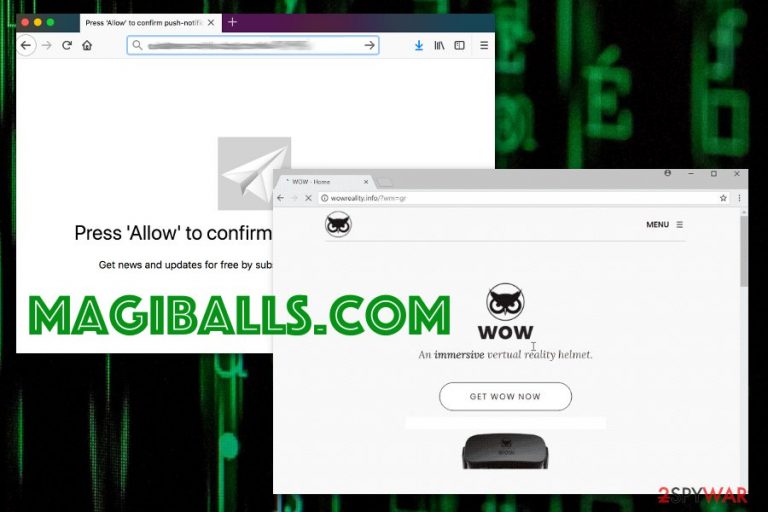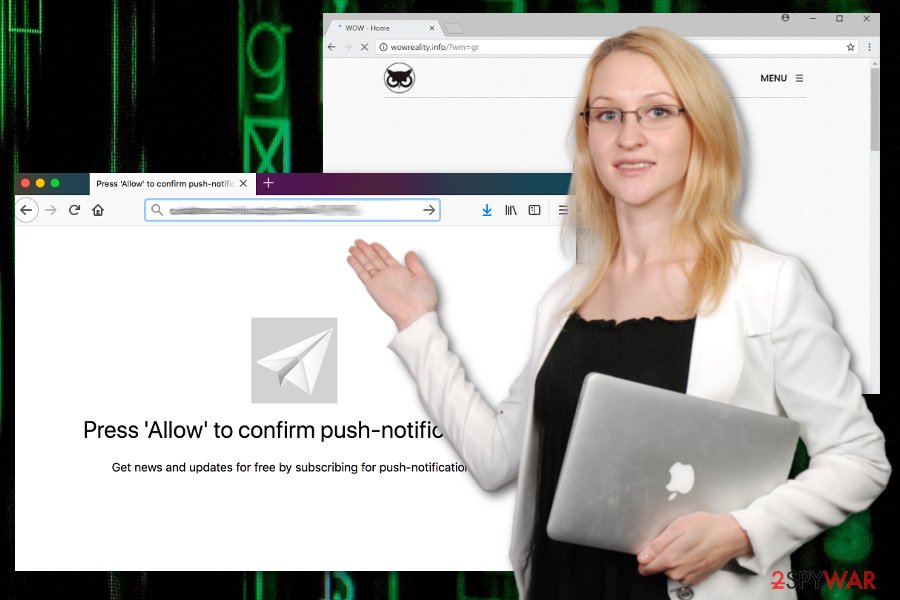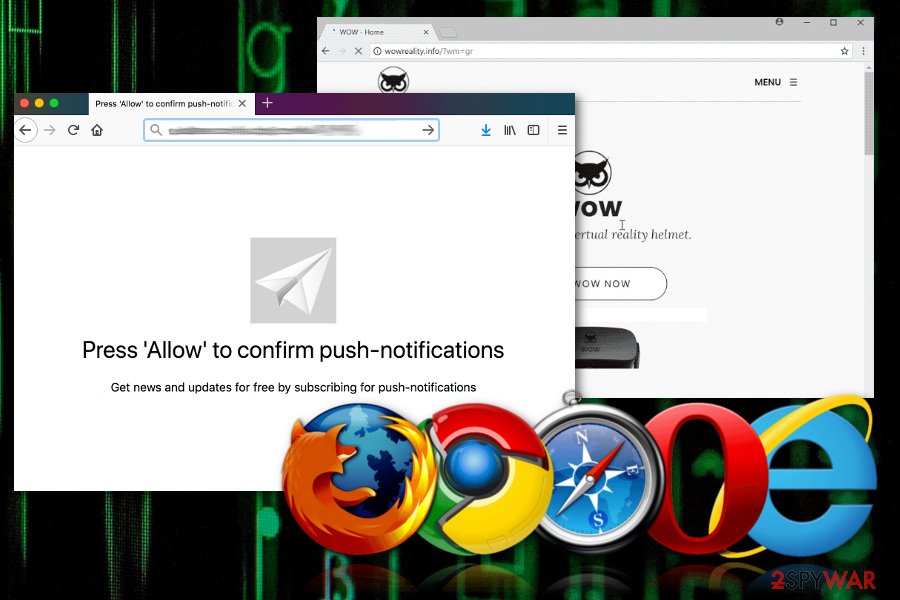Magiballs.com (Free Guide) - Removal Instructions
Magiballs.com Removal Guide
What is Magiballs.com?
Magiballs.com is an adware-related domain you should not trust

Magiballs.com is the pop-up redirect that opens tons of windows and new tabs on the browser to generate views and expose the user to possibly dangerous content. Initially, it is a legitimate service that is used by website developers to monetize advertisements or other content. However, adware[1] authors often misuse this domain in order to inject ads without permission.
Once such a program gets on the system, various problems occur and start annoying the visitor with pop-up ads, redirects, and changed settings of the Google Chrome, Mozilla Firefox, Internet Explorer, Safari browsers. Without a doubt, these activities can negatively impact the web browsing experience and lead to misleading websites.
Even though the Magiballs.com virus is not a correct term for the potentially unwanted program, it is called that due to its intrusive nature. It is important to note that there could be numerous different applications behind browser redirects, so you should investigate your computer and browsers carefully.
| Name | Magiballs.com |
|---|---|
| Type | Adware |
| Symptoms | Web browser settings might change, ads and redirects may be encountered on a regular basis |
| Distribution | Software bundles, deceptive third-party websites |
| Damage | The PUP exposes the user to possibly dangerous content and can lead to privacy issues due to common data tracking functionality[2] |
| Elimination | We recommend using automatic malware removal tools, although manual instructions are also available below |
| System repair | Since the potentially unwanted program runs in the background and can alter some settings like registry and startup preferences, you should rely on FortectIntego that can easily fix most system-related issues |
If you encounter a pop-up that is marked “Ads from Magiballs,” your device might be infected with adware, which is usually installed without your permission or knowledge. Alternatively, your system might be clean, and you could have accessed the site after clicking on some weird link online.
Therefore, it is not enough to leave the page since there could be PUPs running in the background – redirects will not stop until they are removed. The sooner you get rid of adware, the better because in time, such intruders can migrate from web browsers to system settings and inject the dangerous content there to increase the persistence.
Additionally, information-tracking functions and personalized content can interfere with your everyday online browsing. There is no need to keep browsing on the site or allowing the PUP to make wanted changes. You need to clean the machine as soon as possible, so additional damage can be avoided entirely.

- links and sites that you visit;
- browser tools you use;
- browsing history;
- OS type;
- IP address;
- location;
- most visited pages and often searched items.
While most of this data is non personal, you should still avoid being tracked by various third-parties when it is not necessary. Personalized ads generate more views and views make more revenue, so you can help make a profit for the sponsor.
Unfortunately, that means that you get exposed to more malicious material online and can get dangerous malware installed beside the PUP. To avoid such installation, you should pay close attention to the sites you end up visiting and try to clean the machine as soon as possible.
For the proper Magiballs.com removal, experts[3] always recommend choosing a professional anti-malware that can check the system fully for all the traces and hidden files of the intruder. However, we should also note the damage these PUPs can cause to your device. Since the application runs in the background, you cannot be sure that important places like the registry or system settings are not affected. Run FortectIntego to see if there is any damage that needs repairing. 
Pay attention to any freeware installations
Anything downloaded from the internet can pose a risk on the machine because you cannot be 100% sure that the program you installed is secure and has nothing possibly harmful about it. Unfortunately, the risk is more significant when you use p2p services, torrents, and free download pages as your primary application sources. You can avoid PUP infiltrations by:
- choosing official sources, providers or developers;
- always going through the EULA of the page you visit and use frequently;
- selecting Advanced or Custom options of the installation;
- de-selecting anything suspicious from the installation list that appears on the screen;
- keeping the AV tool on the machine to get rid of anything malicious.
Clean your computer in a few simple steps
You need to note that infection symptoms are not related to the web browser only. Redirect virus or push notifications causing PUP is mainly running on the web browser because the main focus is online traffic, advertising material.
However, PUP removal needs to happen on the system of the infected machine where all the possible intruders and harmful files can get deleted. For the best results, you should go for the automatic method involving the anti-malware tools and programs designed for such a process.
If you try to remove Magiballs.com manually, you should note that that there is more to this intruder than the redirects and other symptoms. If you go through the web browsers, make sure to set them to default and reverse any settings modified behind your back.
You may remove virus damage with a help of FortectIntego. SpyHunter 5Combo Cleaner and Malwarebytes are recommended to detect potentially unwanted programs and viruses with all their files and registry entries that are related to them.
Getting rid of Magiballs.com. Follow these steps
Uninstall from Windows
Instructions for Windows 10/8 machines:
- Enter Control Panel into Windows search box and hit Enter or click on the search result.
- Under Programs, select Uninstall a program.

- From the list, find the entry of the suspicious program.
- Right-click on the application and select Uninstall.
- If User Account Control shows up, click Yes.
- Wait till uninstallation process is complete and click OK.

If you are Windows 7/XP user, proceed with the following instructions:
- Click on Windows Start > Control Panel located on the right pane (if you are Windows XP user, click on Add/Remove Programs).
- In Control Panel, select Programs > Uninstall a program.

- Pick the unwanted application by clicking on it once.
- At the top, click Uninstall/Change.
- In the confirmation prompt, pick Yes.
- Click OK once the removal process is finished.
Delete from macOS
Remove items from Applications folder:
- From the menu bar, select Go > Applications.
- In the Applications folder, look for all related entries.
- Click on the app and drag it to Trash (or right-click and pick Move to Trash)

To fully remove an unwanted app, you need to access Application Support, LaunchAgents, and LaunchDaemons folders and delete relevant files:
- Select Go > Go to Folder.
- Enter /Library/Application Support and click Go or press Enter.
- In the Application Support folder, look for any dubious entries and then delete them.
- Now enter /Library/LaunchAgents and /Library/LaunchDaemons folders the same way and terminate all the related .plist files.

Remove from Microsoft Edge
Delete unwanted extensions from MS Edge:
- Select Menu (three horizontal dots at the top-right of the browser window) and pick Extensions.
- From the list, pick the extension and click on the Gear icon.
- Click on Uninstall at the bottom.

Clear cookies and other browser data:
- Click on the Menu (three horizontal dots at the top-right of the browser window) and select Privacy & security.
- Under Clear browsing data, pick Choose what to clear.
- Select everything (apart from passwords, although you might want to include Media licenses as well, if applicable) and click on Clear.

Restore new tab and homepage settings:
- Click the menu icon and choose Settings.
- Then find On startup section.
- Click Disable if you found any suspicious domain.
Reset MS Edge if the above steps did not work:
- Press on Ctrl + Shift + Esc to open Task Manager.
- Click on More details arrow at the bottom of the window.
- Select Details tab.
- Now scroll down and locate every entry with Microsoft Edge name in it. Right-click on each of them and select End Task to stop MS Edge from running.

If this solution failed to help you, you need to use an advanced Edge reset method. Note that you need to backup your data before proceeding.
- Find the following folder on your computer: C:\\Users\\%username%\\AppData\\Local\\Packages\\Microsoft.MicrosoftEdge_8wekyb3d8bbwe.
- Press Ctrl + A on your keyboard to select all folders.
- Right-click on them and pick Delete

- Now right-click on the Start button and pick Windows PowerShell (Admin).
- When the new window opens, copy and paste the following command, and then press Enter:
Get-AppXPackage -AllUsers -Name Microsoft.MicrosoftEdge | Foreach {Add-AppxPackage -DisableDevelopmentMode -Register “$($_.InstallLocation)\\AppXManifest.xml” -Verbose

Instructions for Chromium-based Edge
Delete extensions from MS Edge (Chromium):
- Open Edge and click select Settings > Extensions.
- Delete unwanted extensions by clicking Remove.

Clear cache and site data:
- Click on Menu and go to Settings.
- Select Privacy, search and services.
- Under Clear browsing data, pick Choose what to clear.
- Under Time range, pick All time.
- Select Clear now.

Reset Chromium-based MS Edge:
- Click on Menu and select Settings.
- On the left side, pick Reset settings.
- Select Restore settings to their default values.
- Confirm with Reset.

Remove from Mozilla Firefox (FF)
Remove dangerous extensions:
- Open Mozilla Firefox browser and click on the Menu (three horizontal lines at the top-right of the window).
- Select Add-ons.
- In here, select unwanted plugin and click Remove.

Reset the homepage:
- Click three horizontal lines at the top right corner to open the menu.
- Choose Options.
- Under Home options, enter your preferred site that will open every time you newly open the Mozilla Firefox.
Clear cookies and site data:
- Click Menu and pick Settings.
- Go to Privacy & Security section.
- Scroll down to locate Cookies and Site Data.
- Click on Clear Data…
- Select Cookies and Site Data, as well as Cached Web Content and press Clear.

Reset Mozilla Firefox
If clearing the browser as explained above did not help, reset Mozilla Firefox:
- Open Mozilla Firefox browser and click the Menu.
- Go to Help and then choose Troubleshooting Information.

- Under Give Firefox a tune up section, click on Refresh Firefox…
- Once the pop-up shows up, confirm the action by pressing on Refresh Firefox.

Remove from Google Chrome
Delete malicious extensions from Google Chrome:
- Open Google Chrome, click on the Menu (three vertical dots at the top-right corner) and select More tools > Extensions.
- In the newly opened window, you will see all the installed extensions. Uninstall all the suspicious plugins that might be related to the unwanted program by clicking Remove.

Clear cache and web data from Chrome:
- Click on Menu and pick Settings.
- Under Privacy and security, select Clear browsing data.
- Select Browsing history, Cookies and other site data, as well as Cached images and files.
- Click Clear data.

Change your homepage:
- Click menu and choose Settings.
- Look for a suspicious site in the On startup section.
- Click on Open a specific or set of pages and click on three dots to find the Remove option.
Reset Google Chrome:
If the previous methods did not help you, reset Google Chrome to eliminate all the unwanted components:
- Click on Menu and select Settings.
- In the Settings, scroll down and click Advanced.
- Scroll down and locate Reset and clean up section.
- Now click Restore settings to their original defaults.
- Confirm with Reset settings.

Delete from Safari
Remove unwanted extensions from Safari:
- Click Safari > Preferences…
- In the new window, pick Extensions.
- Select the unwanted extension and select Uninstall.

Clear cookies and other website data from Safari:
- Click Safari > Clear History…
- From the drop-down menu under Clear, pick all history.
- Confirm with Clear History.

Reset Safari if the above-mentioned steps did not help you:
- Click Safari > Preferences…
- Go to Advanced tab.
- Tick the Show Develop menu in menu bar.
- From the menu bar, click Develop, and then select Empty Caches.

After uninstalling this potentially unwanted program (PUP) and fixing each of your web browsers, we recommend you to scan your PC system with a reputable anti-spyware. This will help you to get rid of Magiballs.com registry traces and will also identify related parasites or possible malware infections on your computer. For that you can use our top-rated malware remover: FortectIntego, SpyHunter 5Combo Cleaner or Malwarebytes.
How to prevent from getting adware
Access your website securely from any location
When you work on the domain, site, blog, or different project that requires constant management, content creation, or coding, you may need to connect to the server and content management service more often. The best solution for creating a tighter network could be a dedicated/fixed IP address.
If you make your IP address static and set to your device, you can connect to the CMS from any location and do not create any additional issues for the server or network manager that needs to monitor connections and activities. VPN software providers like Private Internet Access can help you with such settings and offer the option to control the online reputation and manage projects easily from any part of the world.
Recover files after data-affecting malware attacks
While much of the data can be accidentally deleted due to various reasons, malware is one of the main culprits that can cause loss of pictures, documents, videos, and other important files. More serious malware infections lead to significant data loss when your documents, system files, and images get encrypted. In particular, ransomware is is a type of malware that focuses on such functions, so your files become useless without an ability to access them.
Even though there is little to no possibility to recover after file-locking threats, some applications have features for data recovery in the system. In some cases, Data Recovery Pro can also help to recover at least some portion of your data after data-locking virus infection or general cyber infection.
